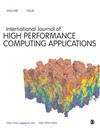Coupling of regional geophysics and local soil-structure models in the EQSIM fault-to-structure earthquake simulation framework
IF 2.5
3区 计算机科学
Q2 COMPUTER SCIENCE, HARDWARE & ARCHITECTURE
International Journal of High Performance Computing Applications
Pub Date : 2021-05-25
DOI:10.1177/10943420211019118
引用次数: 5
Abstract
Accurate understanding and quantification of the risk to critical infrastructure posed by future large earthquakes continues to be a very challenging problem. Earthquake phenomena are quite complex and traditional approaches to predicting ground motions for future earthquake events have historically been empirically based whereby measured ground motion data from historical earthquakes are homogenized into a common data set and the ground motions for future postulated earthquakes are probabilistically derived based on the historical observations. This procedure has recognized significant limitations, principally due to the fact that earthquake ground motions tend to be dictated by the particular earthquake fault rupture and geologic conditions at a given site and are thus very site-specific. Historical earthquakes recorded at different locations are often only marginally representative. There has been strong and increasing interest in utilizing large-scale, physics-based regional simulations to advance the ability to accurately predict ground motions and associated infrastructure response. However, the computational requirements for simulations at frequencies of engineering interest have proven a major barrier to employing regional scale simulations. In a U.S. Department of Energy Exascale Computing Initiative project, the EQSIM application development is underway to create a framework for fault-to-structure simulations. This framework is being prepared to exploit emerging exascale platforms in order to overcome computational limitations. This article presents the essential methodology and computational workflow employed in EQSIM to couple regional-scale geophysics models with local soil-structure models to achieve a fully integrated, complete fault-to-structure simulation framework. The computational workflow, accuracy and performance of the coupling methodology are illustrated through example fault-to-structure simulations.EQSIM断层-构造地震模拟框架中区域地球物理与局部土壤结构模型的耦合
准确理解和量化未来大地震对关键基础设施造成的风险仍然是一个非常具有挑战性的问题。地震现象相当复杂,预测未来地震事件的地震动的传统方法在历史上一直是基于经验的,通过将历史地震的测量地震动数据均匀化为一个公共数据集,并根据历史观测结果概率推导出未来假设地震的地震动。该程序已经认识到了重大的局限性,主要是因为地震地面运动往往是由特定地震断层断裂和特定场地的地质条件决定的,因此是非常特定的场地。在不同地点记录的历史地震往往只有很小的代表性。人们对利用基于物理的大规模区域模拟来提高准确预测地面运动和相关基础设施响应的能力越来越感兴趣。然而,在工程感兴趣的频率下进行模拟的计算要求已被证明是使用区域规模模拟的主要障碍。在美国能源部Exascale Computing Initiative项目中,EQSIM应用程序开发正在进行中,以创建故障到结构模拟的框架。该框架正准备利用新兴的exascale平台,以克服计算限制。本文介绍了EQSIM中使用的基本方法和计算工作流程,将区域尺度的地球物理模型与局部土壤结构模型相结合,以实现一个完全集成、完整的断层-结构模拟框架。通过实例故障-结构仿真,说明了耦合方法的计算流程、准确性和性能。
本文章由计算机程序翻译,如有差异,请以英文原文为准。
求助全文
约1分钟内获得全文
求助全文
来源期刊
CiteScore
6.10
自引率
6.50%
发文量
32
审稿时长
>12 weeks
期刊介绍:
With ever increasing pressure for health services in all countries to meet rising demands, improve their quality and efficiency, and to be more accountable; the need for rigorous research and policy analysis has never been greater. The Journal of Health Services Research & Policy presents the latest scientific research, insightful overviews and reflections on underlying issues, and innovative, thought provoking contributions from leading academics and policy-makers. It provides ideas and hope for solving dilemmas that confront all countries.

 求助内容:
求助内容: 应助结果提醒方式:
应助结果提醒方式:


